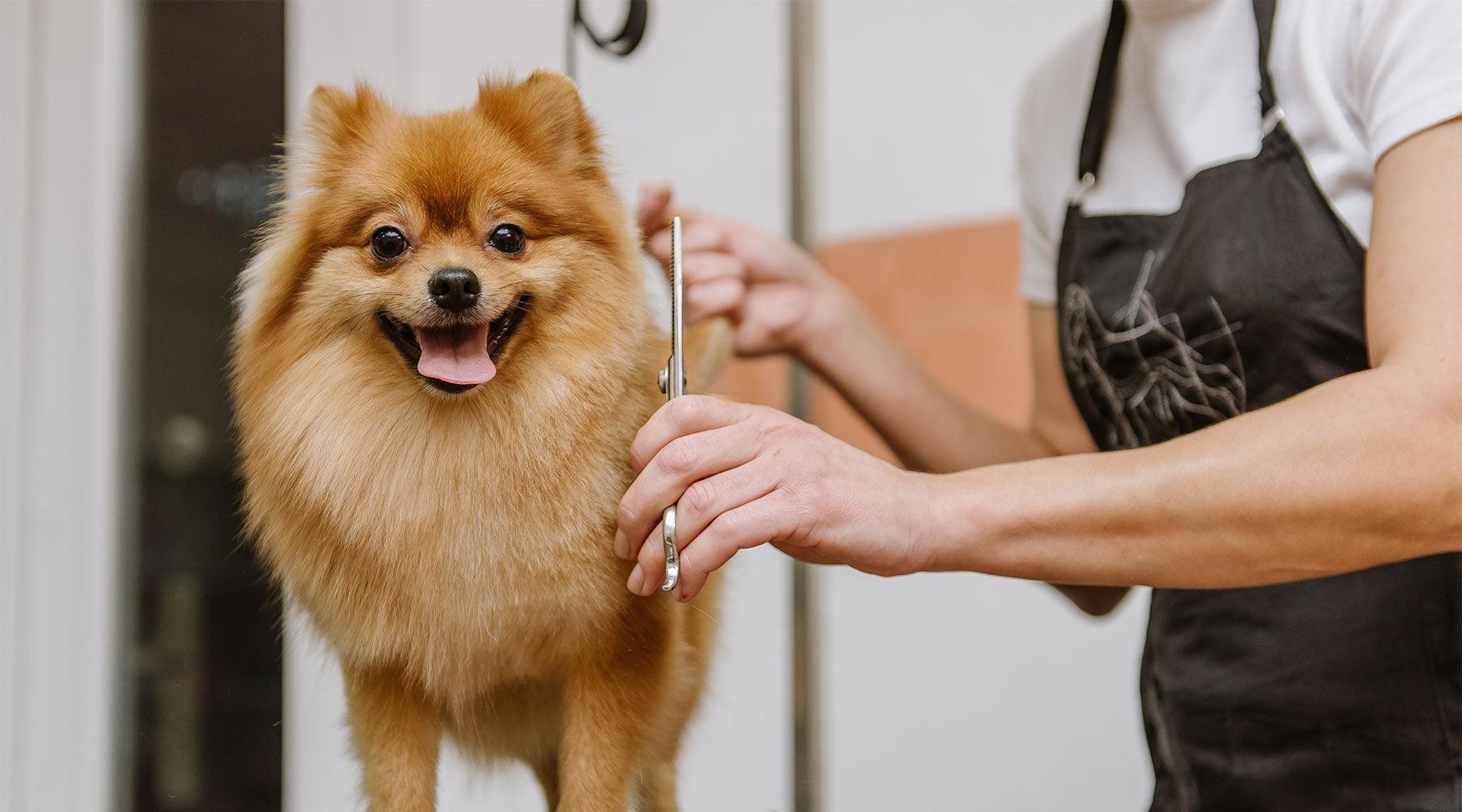Proper grooming is a part of maintaining your pup’s hygiene. Plus, your pet can look much more presentable if you keep their coat in check. However, there are certain questions about clipping a dog’s coat – is it really beneficial, can you do it yourself, and, most importantly, is it safe for your pup?

Let’s answer these questions and look at how and why you should clip your pet’s coat using dog hair clippers.
Is Clipping Your Dog’s Coat Safe?
The first thing to consider on the subject is whether your dog has a single or double coat. How much, how often, or even if you should dog hair clipppers at all will largely depend on the coat type.
If your dog is, for example, an Afghan Hound, Poodle, Boxer, or Maltese, you have a single-coated pup. Of course, these aren’t the only breeds with a single coat. Such breeds may have long or quite short fur, but all will have a relatively even coat and lack the undercoating.
Depending on the particular breed, clipping your pup’s coat may be very useful. It could help cool down the pup at higher temperatures during summer or prevent matting. It’s important not to go overboard with the trimming, though. Let the hair remain at least a couple of centimetres long.
Matters are more complex with double-coated breeds like the Husky, German Shepherd, Golden Retriever, Labrador, or Border Collie. These and other double-coated dogs have an insulating layer of soft hair (or fur) beneath the primary layer. The insulation plays an important role in temperature regulation.
The undercoating sheds in the summer and will grow out relatively quickly once the weather becomes colder. However, the outer coating doesn’t shed nearly as much and grows much slower. As a result, double-coated dogs should never have their hair shortened too much, especially not to the skin.
If you were to cut the hair too short, the undercoating might overgrow the outer coat. In that case, your dog’s appearance could change in colour and texture. Plus, removing too much of the outer hair will leave the pup without adequate protection from the sun.
In conclusion, you’ll need to know which coat type your dog has if you intend on clipping their hair considerably. But if you want to make some small fixes for appearance’s sake, cutting off those scruffy ends shouldn’t be a problem.
And, of course, you’ll need to know what you’re doing to give your pup a proper makeover. Let’s see what you need to know about dog hair clipping.
How to Clip Your Pup’s Hair
First of all, you’ll need the right tools for the job. Believe it or not, human-grade clippers won’t be the right fit. Our hair is thinner and softer than dog hair, so the clippers we use aren’t as sturdy. Also, as much as you love your pet, you probably wouldn’t want to share grooming tools with them.
If you’re worried about the pup not getting the treatment they deserve, you can rest at ease. Quality dog hair clippers like the Andis Clipper AGCB Super 2-Speed are available to ensure your dog gets the best coat care possible.

Once you’ve got the right clipper, you should prepare the coat for trimming with a thorough bath. It would be best to ensure the hair is completely clean of dirt and debris for two reasons. Firstly, it will be easier to spot the places that need trimming on a clean coat. Secondly, the clipper itself will last longer if you avoid clogging it by accident.
If you’re going for a complete trim, you should start from the back, moving from the neck toward the tail. Then, proceed to clip the sides, neck, and chest. These areas will be relatively easy, but the same won’t apply when you get to the face.
Even the calmest dogs won’t tolerate the sound of the clipper around their eyes and noses. That’s why this part of the job is best done with scissors. To that end, you might want to consider a clipper set that includes scissors, like the Fur King Dog Hair Clippers.

You can go back to the clipper for the tail and lower back section. Here, you’ll need to pay extra attention to avoid grazing the tail, especially at the very end.
Finally, clipping the hair on the dog’s stomach can be tricky or very straightforward. This will depend on whether your pup can lie on their back calmly or not. If they can, trimming the area will be easy, and your only concern will be not to hurt the pup’s nipples. But if your dog struggles with keeping still in that position, you’ll need some help.
Move gently throughout the process and avoid getting too close to the pup’s skin. It will be essential not to shorten the hair too much, so it’s best to err on the side of caution.
Does Clipping Help in the Heat?
One of the primary reasons why dog owners decide to shorten their dog’s coat is to help them cool down when it gets too hot outside. But is the attempt actually worthwhile? To answer that question, we’ll need to look at two aspects: the coat’s role in temperature regulation, and how clipping affects this function.
Starting with the coat, temperature maintenance is indeed one of its crucial functions. A dog’s body temperature is usually around 38.6 degrees Celsius, which is most often higher than the temperature of the air. While dogs get their energy from food to heat themselves up, it’s the coat that keeps that heat from dissipating into the air.
The hairs trap air between them, forming a layer of heated air that dissipates slower. Logically, if you shorten the dog’s hair, the insulation will be weaker, helping the pup cool down. Yet, certain potential downsides often come up when discussing the matter.
First, many argue that a dog’s coat is natural and shouldn’t be tampered with. Of course, there’s some truth to this – many breeds developed lush, thick coats to help them cope with the cold. But that argument doesn’t stand when you think of a modern Husky living in Australia. If anything, such dogs can only benefit from some trimming.
Another point is that shortening the dog’s hair makes them more vulnerable to hazards like sunburn and even skin cancer. This risk doesn’t exist if you stick to a particular rule we mentioned earlier: keeping your pup’s coat at least two or three centimetres long.
Finally, there’s a widespread belief that shortening the coat of your pet isn’t efficient for temperature regulation. The reasoning here is that the dog’s skin doesn’t contribute to heat dissipation because they don’t sweat.
This opinion is demonstrably wrong. Sweating isn’t necessary for the skin to radiate excess heat – it will happen naturally, and might even be easier without a thick coat.
In conclusion, clipping your pup’s coat can help them stave off heat. And if you pay attention not to go overboard with the shortening, your furry friend will have no issues as a result.

Essential Tips
If you want to do the job as good as possible, you’ll do good sticking to some key principles. Here are some tips for seamless dog grooming with a dog hair clipper.
- Make sure you understand your dog’s breed entirely. Before you even get the clippers near the pup, study the breed and try to find examples of how such dogs are usually groomed. Use those examples to picture the desired future look of your dog.
- Don’t hesitate to seek out professional help. If clipping your dog’s coat seems like too much of a challenge, it’s best not to take any chances. This is particularly true if you own a breed that’s notably difficult to groom, like Terriers or Poodles.
- Approach your selection of clippers seriously. There are plenty of products in the market, and their quality will usually be related to the price. If you want to make sure you’ve got a decent clipper, consider going for a mid-range option like the Andis Clipper Vida. Or, you could opt for a high-class product and go for the Andis Clipper Pulse ZR II.
- Train your pup to be relaxed around clippers. If your pet is unfamiliar with how the tool looks, smells, and sounds, they’ll be more likely to act restless during the grooming. Start by showing the clipper to the pup – let them sniff it out and look at it from every angle. Then, turn the clipper on and give your dog some treats whenever they stay calm by the working clipper.
- Give the dog some breaks, especially if they’ve never been groomed like this before. Don’t make the first experience into a grooming session that lasts for hours, or your dog might get traumatised.
Make Your Furry Friend Look Their Best
If you follow the best pet grooming practices with clippers, combine them with some common sense, and maintain a positive attitude, your pet will get a new, fresh, gorgeous look in no time. Approach this task with patience and a bit of skill – your pup will appreciate it, particularly once the sweltering months roll in.

